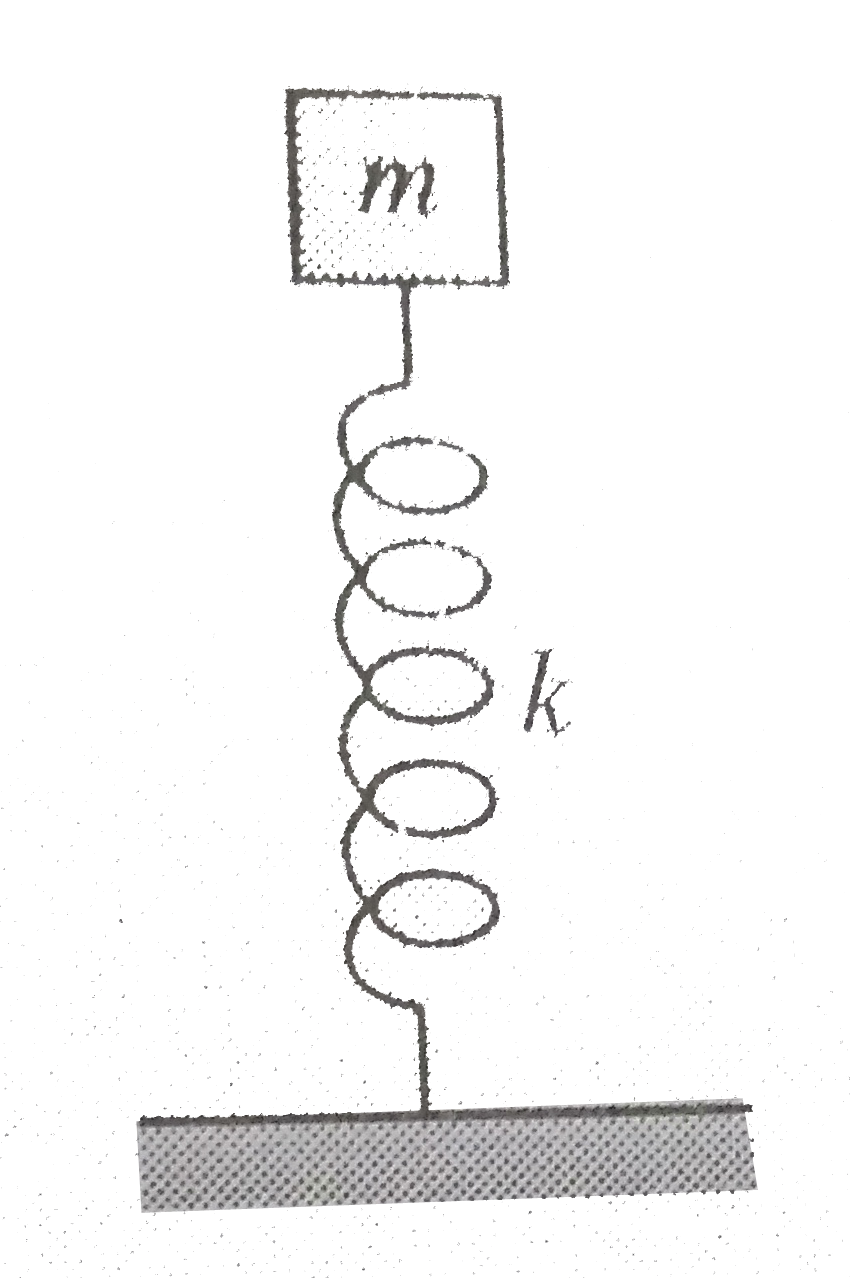A body of mass m is attached to one end of a massless spring which is suspended vertically from a fixed point. The mass is held in hand so that the spring is neither stretched nor compressed. Suddenly the support of the hand is removed. The lowest position attained by the mass during oscillation is 4cm below the point, where it was held in hand.
(a) What is the amplitude of oscillation ?
(b) Find the frequency of oscillation?
1 cm, 4.5Hz
2 cm, 3.51Hz
3 cm, 2.51Hz
4 cm, 1.5Hz
The correct Answer is:B
To solve the problem step by step, we will break it down into two parts: finding the amplitude of oscillation and finding the frequency of oscillation.
1. Understanding the Setup:
- The mass is initially held at a point where the spring is neither stretched nor compressed.
- When released, the mass oscillates and reaches a maximum extension of 4 cm below the initial position.
2. Identifying the Amplitude:
- The amplitude of oscillation (A) is defined as the maximum displacement from the mean position.
- Since the mass reaches 4 cm below the initial position, the amplitude of oscillation is:
A=x2=4cm2=2cm
- Thus, the amplitude of oscillation is 2 cm.
Part (b): Finding the Frequency of Oscillation
1. Using the Formula for Frequency:
- The frequency (f) of oscillation is related to the mass (m) and spring constant (k) by the formula:
T=2π√mk
- Where T is the time period. The frequency is given by:
f=1T=12π√km
2. Relating the Spring Constant to the Given Information:
- From energy conservation, we have:
mgx=12kx2
- Where x=4cm=0.04m.
- Rearranging gives:
k=2mgx
3. Substituting for Frequency:
- Substitute k into the frequency formula:
f=12π√2mgxm=12π√2gx
- Using g≈10m/s2 and x=0.04m:
f=12π√2×100.04=12π√500≈12π×22.36≈22.366.28≈3.56Hz
Final Answers:
- (a) Amplitude of oscillation: 2 cm
- (b) Frequency of oscillation: 3.56 Hz
- The mass is initially held at a point where the spring is neither stretched nor compressed.
- When released, the mass oscillates and reaches a maximum extension of 4 cm below the initial position.
- The amplitude of oscillation (A) is defined as the maximum displacement from the mean position.
- Since the mass reaches 4 cm below the initial position, the amplitude of oscillation is:
A=x2=4cm2=2cm
- Thus, the amplitude of oscillation is 2 cm.
- The frequency (f) of oscillation is related to the mass (m) and spring constant (k) by the formula:
T=2π√mk
- Where T is the time period. The frequency is given by:
f=1T=12π√km
- From energy conservation, we have:
mgx=12kx2
- Where x=4cm=0.04m.
- Rearranging gives:
k=2mgx
- Substitute k into the frequency formula:
f=12π√2mgxm=12π√2gx
- Using g≈10m/s2 and x=0.04m:
f=12π√2×100.04=12π√500≈12π×22.36≈22.366.28≈3.56Hz
- (a) Amplitude of oscillation: 2 cm
- (b) Frequency of oscillation: 3.56 Hz
Topper's Solved these Questions
- BOOK - NCERT FINGERTPS ENGLISHCHAPTER - OSCILLATIONS EXERCISE - Higher Order Thinking Skills8videos
OSCILLATIONS
- BOOK - NCERT FINGERTPS ENGLISHCHAPTER - OSCILLATIONS EXERCISE - Exemplar Problems9videos
OSCILLATIONS
- BOOK - NCERT FINGERTPS ENGLISHCHAPTER - MOTION IN A STRAIGHT LINEEXERCISE - NCERT Exemplar6videos
MOTION IN A STRAIGHT LINE
- BOOK - NCERT FINGERTPS ENGLISHCHAPTER - PHYSICAL WORLDEXERCISE - Assertion And Reason10videos
PHYSICAL WORLD
Similar Questions
A body of mass m is attached ot one end of a massless spring which is suspended vertically form a fixed point. The mass is held in hand, so that the spring is neither stretched nor compressed. The lowest position attained by the mass during oscillation is 4 cm below the point, where it was held in hand.
(a) What is the amplitude of oscillation?
(b) Find the frequency of oscillation?View Solution"A mass is attached to one end of a spring and by holding the other end in hand, the spring is whirled in a horizontal circle" What happens to the length of the spring ?
View SolutionA spring with one end attached to a mass and the other to a right support is stretched and released
View SolutionA 100 g mass stretches a particular spring by 9.8 cm, when suspended vertically from it. How large a mass must be attached to the spring if the period of vibration is to be 6.28 s?
View SolutionTwo equal masses are attached to the two ends of a spring of spring constant k. The masses are pulled out symmetrically to stretch the spring by a length x over its natural length. The work done by the spring one each mass is
View SolutionA mass is attached to the end of a string of length l which is tied to a fixed point O. The mass is released from the initial horizontal position of the string. Below the point O at what minimum distance a peg P should be fixed so that the mass turns about P and can describe a complete circle in the vertical plane?
View SolutionA block of mass m held touching the upper end of a light spring of force constant K as shown in figure. Find the maximum potential energy stored in the spring if the block is released suddenly on the spring.
 View Solution
View SolutionA block of mass m attached in the lower and vertical spring The spring is hung from a calling and force constant value k The mass is released from rest with the spring initially unstreched The maximum value of extension produced in the length of the spring will be
View SolutionA mass of 0.2 kg is attached to the lower end of a massless spring of force constant 200Nm the other end of which is fixed to a rigid support. Study the following statements.
View SolutionIf the mass attached to a vertical spring is pulled down and left, it oscillates. why ?
View Solution

